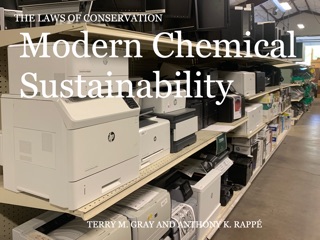Modern Chemical Sustainability: The Laws of Conservation is the third of a series of e-textbooks used at Colorado State University for non-science majors in the Chemistry in Context course. The first two books are: Energy: What the World Needs Now and Molecules of Life with a Chemistry Bootcamp. The third book has more of case study feel to it—covering topics like air pollution and acid rain, chlorofluorocarbons (CFCs) and the ozone hole, environmentally persistent biologically active anthropogenic organic chemicals, water, materials use, electronic waste, and others. In these case studies topics of chemistry such as acids and bases, chemical reactivity, molecular structure, and others are introduced as needed. The third book is also used in an interdisciplinary electronic waste course.
The title is a double entendre. Notions and strategies for conservation are often associated with sustainability. Conserving a resource is often the very mechanism to its sustainable use. Chemists also think about conservation via the Law of Conservation of Matter. Materials and resources are not really used up. They are merely changed in form. They may be used up in the sense that the easy to obtain form is gone and now the substance will be harder to get in the future. But surely the permanence of the basic building blocks of materials must be taken into account. For example, even if we dump all the phosphorus in the ocean through wasteful fertilizer use, it is still in the ocean available for future mining—although perhaps to be obtained at a higher cost and with more energy use.
The audience is non-science college students, advanced high school students, and general readers. In addition to chemistry and physical science courses, this book could be a supplemental textbook for courses on sustainability and environmental science. While not the main textbook for these courses, it could provide some technical background written at an appropriate level.



